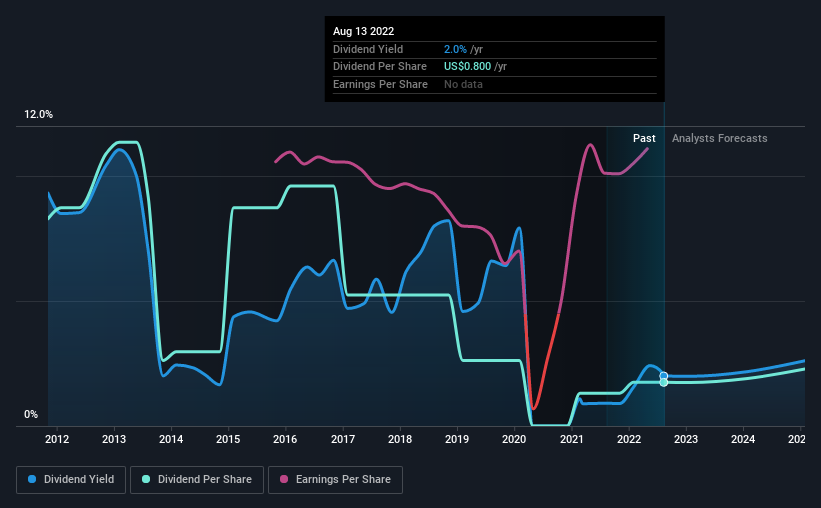Bath & Body Works (NYSE:BBWI) Could Be A Buy For Its Upcoming Dividend
Bath & Body Works, Inc. (NYSE:BBWI) stock is about to trade ex-dividend in three days. The ex-dividend date is usually set to be one business day before the record date which is the cut-off date on which you must be present on the company's books as a shareholder in order to receive the dividend. The ex-dividend date is of consequence because whenever a stock is bought or sold, the trade takes at least two business day to settle. Thus, you can purchase Bath & Body Works' shares before the 18th of August in order to receive the dividend, which the company will pay on the 2nd of September.
The company's next dividend payment will be US$0.20 per share, and in the last 12 months, the company paid a total of US$0.80 per share. Based on the last year's worth of payments, Bath & Body Works has a trailing yield of 2.0% on the current stock price of $39.99. We love seeing companies pay a dividend, but it's also important to be sure that laying the golden eggs isn't going to kill our golden goose! As a result, readers should always check whether Bath & Body Works has been able to grow its dividends, or if the dividend might be cut.
See our latest analysis for Bath & Body Works
If a company pays out more in dividends than it earned, then the dividend might become unsustainable - hardly an ideal situation. Bath & Body Works has a low and conservative payout ratio of just 15% of its income after tax. Yet cash flow is typically more important than profit for assessing dividend sustainability, so we should always check if the company generated enough cash to afford its dividend. What's good is that dividends were well covered by free cash flow, with the company paying out 17% of its cash flow last year.
It's positive to see that Bath & Body Works's dividend is covered by both profits and cash flow, since this is generally a sign that the dividend is sustainable, and a lower payout ratio usually suggests a greater margin of safety before the dividend gets cut.
Click here to see the company's payout ratio, plus analyst estimates of its future dividends.
Have Earnings And Dividends Been Growing?
Stocks in companies that generate sustainable earnings growth often make the best dividend prospects, as it is easier to lift the dividend when earnings are rising. Investors love dividends, so if earnings fall and the dividend is reduced, expect a stock to be sold off heavily at the same time. With that in mind, we're encouraged by the steady growth at Bath & Body Works, with earnings per share up 4.3% on average over the last five years. Bath & Body Works is retaining more than three-quarters of its earnings and has a history of generating some growth in earnings. We think this is a reasonable combination.
Another key way to measure a company's dividend prospects is by measuring its historical rate of dividend growth. Bath & Body Works's dividend payments per share have declined at 14% per year on average over the past 10 years, which is uninspiring. Bath & Body Works is a rare case where dividends have been decreasing at the same time as earnings per share have been improving. It's unusual to see, and could point to unstable conditions in the core business, or more rarely an intensified focus on reinvesting profits.
The Bottom Line
Is Bath & Body Works worth buying for its dividend? Earnings per share have been growing moderately, and Bath & Body Works is paying out less than half its earnings and cash flow as dividends, which is an attractive combination as it suggests the company is investing in growth. We would prefer to see earnings growing faster, but the best dividend stocks over the long term typically combine significant earnings per share growth with a low payout ratio, and Bath & Body Works is halfway there. It's a promising combination that should mark this company worthy of closer attention.
So while Bath & Body Works looks good from a dividend perspective, it's always worthwhile being up to date with the risks involved in this stock. Every company has risks, and we've spotted 4 warning signs for Bath & Body Works (of which 1 is significant!) you should know about.
A common investing mistake is buying the first interesting stock you see. Here you can find a full list of high-yield dividend stocks.
Have feedback on this article? Concerned about the content? Get in touch with us directly. Alternatively, email editorial-team (at) simplywallst.com.
This article by Simply Wall St is general in nature. We provide commentary based on historical data and analyst forecasts only using an unbiased methodology and our articles are not intended to be financial advice. It does not constitute a recommendation to buy or sell any stock, and does not take account of your objectives, or your financial situation. We aim to bring you long-term focused analysis driven by fundamental data. Note that our analysis may not factor in the latest price-sensitive company announcements or qualitative material. Simply Wall St has no position in any stocks mentioned.
Join A Paid User Research Session
You’ll receive a US$30 Amazon Gift card for 1 hour of your time while helping us build better investing tools for the individual investors like yourself. Sign up here

 Yahoo Finance
Yahoo Finance 
